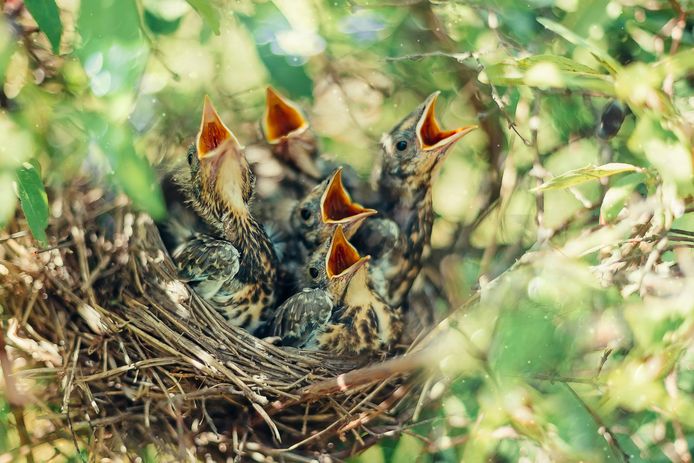At that time of the year again. You are walking or working in the garden and suddenly you come across a little bird. One of which you think should remain in its nest. Our first instinct is often to help right away, but is that the right reaction? What do you do best? Science journalist Martin Peters found out.
What do you do if you come across a helpless baby bird? According to Vogelbescherming Vlaanderen and Natuurhulpcentrum, it is best to first look at what the bird looks like.
If the young’s plumage is patchy and there are no external injuries and you know where the nest is, place the young bird back in the nest. Unlike mammals, leaving scent behind cannot harm young birds. Be aware that mother birds will sometimes deliberately push their young out of the nest if they notice that something is wrong or that they are dying. It sounds harsh, but they do it to increase the chances of other chicks surviving. If you have no idea where the nest is or if it is broken, take the bird to the nearest bird sanctuary. Do this even if the bird is injured.
Read more below the image.

If the young’s plumage is full and there are no injuries, nothing necessarily needs to be done. Older young will often jump out of a very small nest to do flying exercises. They do this both on the ground and in the bushes. It may take several days for you to succeed. But do not panic, parents stay close to them to feed and protect their children.
So it’s best to stay away from the bird in the first place. However, if you notice danger in the area, such as predators or traffic, you can place the bird in a woodland or hedge where it is safe. Do this within a radius of a few metres. Then leave the bird alone again. do you have a cat Then keep it indoors. If you notice that the young bird is injured, it is best to take it to a bird rescue center.
There are also so-called chicks. These birds usually breed on the ground. Their young already have fluff feathers when they are born and are able to wander right away. The bird is a case in point. These youngsters are quickly independent and can easily reach safety in case of danger. So stay away is the message.
What you definitely shouldn’t do is try to raise the young yourself. It is not always easy to know the species and the required food. You also run the risk of the young bird becoming too tame without getting close to the living creatures. And if this is the case, then you cannot release the bird into nature.
look. How can you tell the difference between Asian and European hornets?
look. The holiday maker unknowingly carries one of the deadliest snails in the world: a “dangerous carnivore”
“On average, 4,000 to 7,000 animals live in an anthill”: How do you get ants out of your home? (+)
Unlimited free access to Showbytes? Which can!
Log in or create an account and never miss a thing from the stars.

“Total coffee specialist. Hardcore reader. Incurable music scholar. Web guru. Freelance troublemaker. Problem solver. Travel trailblazer.”







More Stories
GALA lacks a chapter on e-health
Weird beer can taste really good.
Planets contain much more water than previously thought